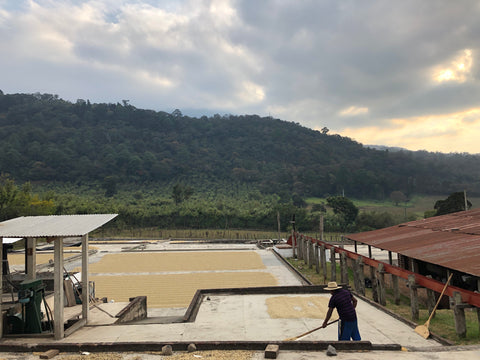Today we visited the beautiful Hacienda Carmona de Pulcal and Buena Vista, two farms in Guatemala we've purchased from for numerous years and both of which are currently available on our menu.
Pulcal is a 1000 hectare farm that’s located on the slope of Agua Volcano, though 800 hectares are actually left to natural forest and reserves. The remaining 200 hectares are split amongst coffee and dairy. We were able to see and interact with both. As a fun fact, last year we decided to get hands on and try milking the cows - something both Dave and myself had never done. Look for our post about Pulcal from last season to read more about this.
We drove through the farm and got to see a good chunk of the coffee plants that are currently in production. The last two seasons, we’ve purchased a mixed variety offering of Bourbon and Typica - it’s been very well structured, nicely balanced and had flavours of cola and cherry. These coffees looked very healthy this year, with optimal amounts of rain coming in the early season and a nice amount of sun pushing the energy into the cherries for ideal maturation.

Something we’re excited about this season is a new plot of land that’s producing Java, a variety of coffee that’s related to Bourbon, but has a slightly different flavour profile and has shown great resistance to leaf rust - something that the Typica has never been known for. Luis Pedro Zelaya Zamora, the manager of Pulcal, explained to us his excitement about Java and the future it might hold for quality and production. Look for this on our menu later this year!
As far as processing goes, Pulcal has been using a beautiful old de-pulper for more than 30 years. It’s incredibly well maintained as you can see in the photos and does a fantastic job in terms of quality of separating and removal of the cherry. All the coffee at Pulcal is finished as a washed coffee, with a 10-14 hour dry fermentation, followed by cleaning in a serpentine channel, and left to dry on patios for 12-15 days depending on the weather. This results in the coffees being clean, showing varietal characteristic, and for us, longevity of flavour as it ages.

We're excited for a fresh crop offering of Pulcal to arrive on our menu in the next few months.

Later in the day, we made our way to Buena Vista, a farm that this year will be our 5th season purchasing coffee from. It’s been a best seller on our menu for many years and when you see the farm, you’d understand why. It sits much higher up than Pulcal, as far as altitude goes, approximately 1750-1900 metres, and overlooks Antigua with Volcan de Agua in the background.
The farm is terraced beautifully, with very strategically planted shade trees - Ingas - planted throughout the rows of coffee. It’s a picturesque farm that produces beautiful coffees.

It was interesting to see the differences between Pulcal and Buena Vista as they’re not farmed from one another geographically. But Buena Vista managed to get far less rain and has had a lot of difficulty maturing the coffee cherries. The average coffee plant takes about 8 months from flowering to ripe cherry. A sufficient rainy season is necessary for the plant to grow and situate itself for a successful crop. This year, it’s a shame because Buena Vista and many other surrounding farms are experiencing what we call a bumper crop, where there’s an increased yield of production over the prior year, but due to the lack of rain during the rainy season, a high percentage of the coffee cherries are not fully maturing. Similar to wine, producers can’t control the weather and depend so greatly on it for their success in a season.
We’re still excited with having Buena Vista back this coming year. We’re sad to see that a lot of the trees are battling through the dry climate and soil conditions, but we think the offering will still be great. Thanks to the differential in altitude, the trees toward the top of the farm seem to be doing quite a lot better then those toward the bottom. We’ll bring in Villasarchi again this year, with the potential of some Java, similar to Pulcal. And we cupped a really unique Geisha that Luis Pedro refers to as Malawi Geisha. *There's a small amount of this planted at Pulcal as well that we're trying to get our hands on.*
There’s no dry mill located on this farm. Rather, the cherries are loaded into a truck every day after harvesting and brought to Bella Vista, the wet mill that’s also run by Luis Pedro, for processing. In the five years we’ve visited Guatemala, they’ve made vast improvements every season. This year, they’ve installed a centrifuge to help mitigate the amount of water they consume and to make their processing much more efficient. It spins incredibly quickly and through this momentum it’s able to rid the coffee of a large amount of the water that sits between the seed and the fruit of the cherry. With the same momentum, it’s able to move the coffee seeds through a tube and into the fermentation tanks on the far side of the mill. We think it’s a great addition to the production. You can see a photo of Bella Vista below.

Tomorrow we’re flying to Huehuetenango to meet Zoila Teresa Aguilar, a small producer who last year we featured on our menu. Wish us luck!





1 comment
Hi!
I love your coffee and your stories and posts on Instagram. It’s very cool and interesting to see faraway places and learn more about coffee and where it comes from. I’m confused though… I thought Buena Vista was from Guatemala?